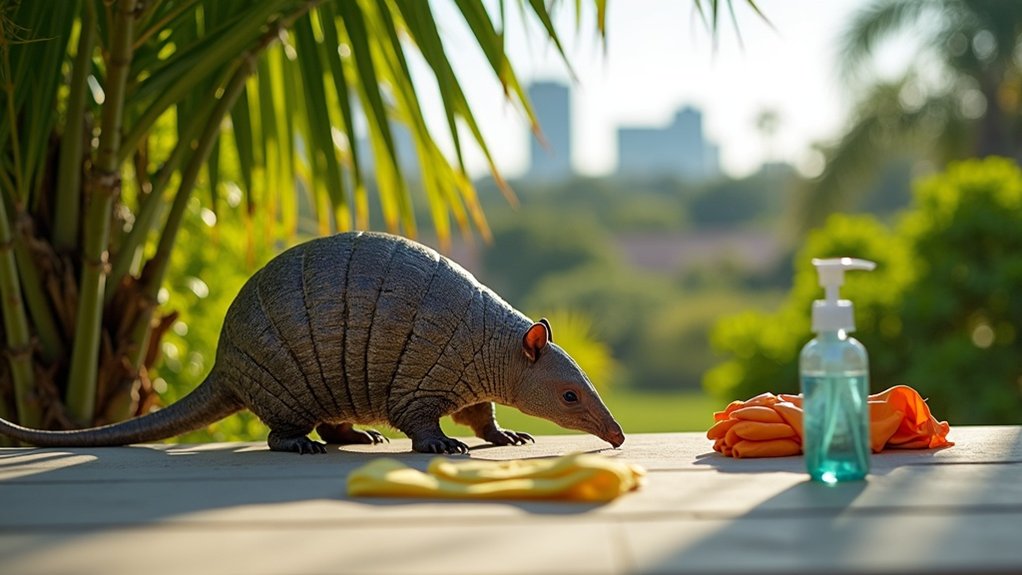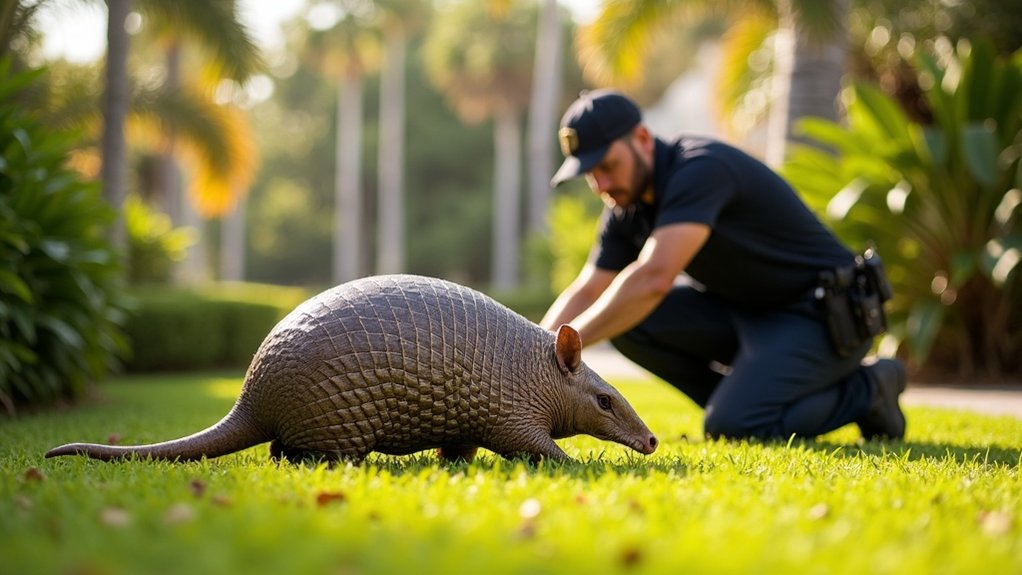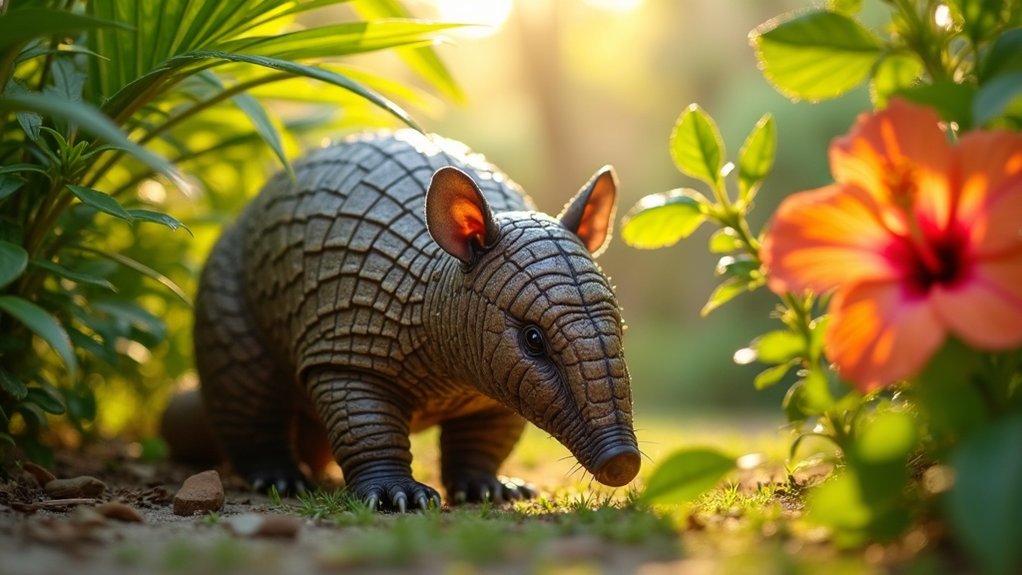If you’ve ever wondered about the wildlife in Miami, you might be curious about whether armadillos are part of the scene. These unique creatures have a fascinating history in the area that could surprise you. Understanding their presence is important, especially if you’re a gardener or simply enjoy checking out local nature. So, what exactly can you expect from these nocturnal animals, and how do they fit into Miami’s ecosystem? Stick around, and let’s analyze into the intriguing world of armadillos and their impact right here in the Magic City.
Species Presence in Miami: The Nine-Banded Armadillo
The nine-banded armadillo (Dasypus novemcinctus) is a common species found in Miami’s rich ecosystem. This animal, which is native to the area, typically measures around 15 to 17 inches in length and is easily identifiable by its distinctive leathery shell.
First recorded in the United States in the late 1800s, the nine-banded armadillo has since made its way to Florida, adapting well to various habitats.
As nocturnal foragers, nine-banded armadillos primarily hunt for insects and small invertebrates during the night, using their strong sense of smell to locate food. While they play a role in maintaining the balance of the ecosystem, their burrowing habits can sometimes lead to issues for homeowners, particularly in gardens and landscaped areas.
To address potential damage caused by armadillos, it’s important to implement effective wildlife control strategies. These can include habitat modification, such as removing debris that provides shelter, or using fencing to protect specific areas of your yard.
Preferred Habitat of Armadillos

Armadillos are adaptable creatures, but their preferred habitats significantly boost their quality of life. These animals thrive in forested or semi-open environments, where loose soil allows them to burrow and forage effectively. In places like Miami, Florida, armadillos are often found near water sources, which provide both an abundance of food and necessary shelter.
Their nocturnal nature means that armadillos are primarily active at night, searching for insects and plants to eat. This behavior highlights the importance of suitable habitats for their survival.
Here’s a closer look at the types of habitats armadillos prefer:
| Habitat Type | Characteristics |
|---|---|
| Forested Areas | Rich in loose soil and abundant food sources |
| Semi-Open Spaces | Include shrubs and bushy trees for cover |
| Near Water Bodies | Offer improved access to food and shelter |
| Urban/Suburban Areas | Adapted to environments altered by humans |
Understanding these habitat preferences can help you identify where armadillos might live in your area. By recognizing their needs, you can appreciate the role these fascinating creatures play in our ecosystem and support their conservation in your local environment.
Signs of Armadillo Activity in Gardens and Yards

If you notice unusual disturbances in your garden or yard, these could be signs of armadillo activity. Armadillos are known for their digging habits, and one of the most recognizable indicators of their presence is the appearance of distinctive holes in the ground that measure about 3-5 inches in diameter.
These shallow, conical holes are typically created as armadillos forage for food, such as insects and grubs, which can disrupt the soil and potentially damage your plants and bulbs.
In addition to the holes, you may find loose dirt and small soil piles near the digging sites. These are further confirmations of armadillo activity in your area.
It’s important to address these signs promptly, as burrowing too close to structures can compromise foundations and lead to costly repairs.
If you find yourself dealing with armadillos in your garden, consider reaching out to wildlife control services. They can help safely remove the animals and provide guidance on preventing future visits.
Taking these steps can help protect your outdoor space and maintain the health of your garden.
Potential Risks and Nuisances of Armadillo Infestation

Armadillo infestations can present significant challenges for homeowners and property managers. These creatures are known for their burrowing habits, which can lead to structural issues in buildings. When armadillos dig, their extensive burrows can undermine foundations, potentially resulting in costly repairs and creating hazards for utility lines, such as water and gas pipes.
In addition to structural concerns, armadillos can cause damage to gardens and lawns through their foraging behavior. They create shallow holes that can uproot plants and disrupt landscaping efforts. This can be particularly frustrating for avid gardeners who invest time and resources into maintaining their outdoor spaces.
Moreover, the presence of armadillos can inadvertently attract other wildlife, such as snakes, which may pose additional safety risks. This can be especially concerning in residential areas or near recreational spaces like golf courses, where armadillo digging can detract from the aesthetic appeal and usability of the landscape.
It’s also important to note that the burrows created by armadillos can present tripping hazards for both people and pets. These risks highlight the need for effective wildlife management strategies.
Implementing measures to prevent armadillo infestations and seeking professional wildlife removal services can help mitigate these issues, protecting your property and making sure a safer environment.
Understanding the potential risks associated with armadillo infestations is crucial for effective management, and taking proactive steps can save time, money, and stress in the long run.
Health Precautions When Encountering Armadillos

When you come across armadillos, it’s important to steer clear of direct contact because of the possible risk of leprosy bacteria transmission.
Be sure to wash your hands thoroughly before and after handling anything that might’ve been in contact with these animals. Taking these simple steps can really help minimize any health risks associated with armadillos.
Now that we’ve covered that, let’s move on to some other wildlife safety tips you should keep in mind.
Avoid Direct Contact
While armadillos may appear harmless, it’s important to steer clear of direct contact with them due to potential health risks. One significant concern is that armadillos can carry the bacteria responsible for leprosy, which, although rare, has been associated with human cases in parts of the Southern USA.
To protect yourself, it’s advisable to avoid touching armadillos or their habitats. If you encounter an armadillo or find evidence of their presence, consider reaching out to professional wildlife services. These experts are trained to handle such situations safely and can assist with the removal of the animal, making sure that both you and the wildlife are treated with care.
Taking these precautions is crucial since wildlife can carry diseases that pose a risk to human health. By staying informed and vigilant, you can help safeguard your well-being and the health of your community.
Wash Hands Thoroughly
Maintaining proper hygiene after interacting with armadillos or their environments is crucial for your health. These animals can carry diseases, including leprosy, which makes washing hands thoroughly an important step in reducing health risks.
Here are some practical guidelines to follow:
- Use Gloves: When handling materials that might be contaminated with germs from armadillos, always wear gloves. This simple precaution helps prevent direct contact and reduces the risk of exposure to potential diseases.
- Wash Hands Thoroughly: It’s essential to wash your hands with soap and water both before and after any contact with armadillos or their habitats. This practice effectively removes any contaminants and helps make sure your safety.
- Sanitize Tools: If you’re using tools or equipment in areas where armadillos may have been present, make it a habit to regularly disinfect them. This helps minimize the risk of disease transmission and keeps your environment safer.
By following these guidelines, you can enjoy interactions with wildlife while prioritizing your health and well-being.
Effective Prevention Methods for Armadillo Issues

To keep armadillos from making themselves at home in your yard, it’s important to maintain your property and consider some fencing options. A clean yard without debris or food sources can really help minimize what attracts them.
You might also want to think about putting up mesh fences that go deep into the ground; this can stop them from digging under the fence.
Speaking of property care, let’s look at some other ways to protect your yard from various wildlife.
Yard Maintenance Practices
Maintaining a tidy yard is crucial for managing armadillo populations, as these animals are drawn to environments that offer food and shelter.
Here are some effective yard maintenance practices to help you keep armadillos at bay:
- Remove Debris: Regularly clear your yard of brush piles, fallen branches, and tall grass. These areas can serve as hiding spots for armadillos, making your yard more attractive to them.
- Secure Gardens: If you have a garden, consider installing mesh fencing around its perimeter. For maximum effectiveness, bury the fencing 12-24 inches deep to prevent armadillos from digging underneath.
- Use Natural Repellents: Applying natural repellents like garlic and cayenne pepper around the edges of your garden can help deter armadillos. Their keen sense of smell makes these substances effective deterrents.
In addition to these practices, it’s important to regularly monitor your yard for signs of digging or burrowing.
If you notice any activity, addressing it promptly can help minimize damage to your landscaping and discourage armadillos from returning.
Fencing and Barriers
Armadillos can be a common nuisance for homeowners due to their burrowing habits. However, implementing effective fencing and barriers can significantly minimize their presence in your yard. To create an effective barrier, consider installing a mesh fence that stands at least 2 feet high and burying the bottom 12 to 24 inches underground. This design helps prevent armadillos from digging under the fence, which is a behavior they often exhibit.
In addition to mesh fencing, using solid barriers around gardens can further reduce the likelihood of armadillos accessing your property. These animals typically struggle to dig through compacted soil, making solid barriers an effective solution.
It’s also wise to regularly inspect your fencing for any gaps or weaknesses. Addressing these areas promptly can help maintain a secure perimeter.
To boost your defenses, you can combine physical barriers with natural repellents. Substances like garlic or cayenne pepper can act as deterrents, making your yard less inviting to armadillos.
For those seeking an additional layer of protection, electric fencing might be worth considering. Armadillos are sensitive to vibrations and often avoid areas that create discomfort, making this a viable option for keeping them at bay.
Professional Wildlife Control Services for Armadillo Removal

When dealing with an armadillo infestation in Miami, it’s important to consider professional wildlife control services for effective and humane removal.
These experts bring a wealth of experience and knowledge to the table, making certain that the removal process complies with local regulations and is handled with care.
Here are three significant advantages of hiring professionals for armadillo removal:
- Comprehensive Property Inspections: Wildlife control specialists conduct thorough inspections to identify signs of armadillo activity, such as digging and burrowing. This allows them to develop customized removal plans tailored specifically to your property’s needs.
- Humane Trapping Methods: Professionals use live traps to safely capture armadillos, which helps reduce stress and harm to the animals. This approach not only aligns with humane practices but also confirms that the animals can be relocated without injury.
- Preventing Future Infestations: After the removal process, experts take additional steps to prevent future issues. They fill and seal burrows to eliminate potential nesting sites and can provide ongoing monitoring and preventive strategies, such as installing fencing, to help keep wildlife at bay.
By choosing professional wildlife control services for armadillo removal, you benefit from their expertise and commitment to effective, humane solutions.
This not only resolves the current issue but also helps protect your property from future wildlife intrusions.


